Building a robust referral or affiliate program in a B2B environment can drive high-quality leads and foster strategic partnerships. HubSpot’s CRM and automation capabilities make it possible to design, track, and optimize such programs with precision. Here’s a step-by-step guide covering all the technical essentials: custom UTM fields, 301 redirects, and workflow automation for accurate partner mapping.
Designing Your Referral/Affiliate Program Structure
- Define Program Goals: Decide if you’re rewarding referrals for leads, deals, or both.
- Choose Tracking Method: Will you use unique links, codes, or form submissions?
- Segment Partners/Affiliates: Create lists or properties in HubSpot to differentiate affiliates, partners, or referrers.
- Setting Up Custom UTM Hidden Fields in HubSpot
UTM parameters are critical for tracking the source, medium, and campaign of each referral.
Steps:
Create Custom Properties:
- In HubSpot, go to Settings > Properties > Contact Properties > Create property.
- Add properties for utm_source, utm_medium, utm_campaign, utm_content, and utm_term.
- Add Hidden Fields to Forms:
- Edit your HubSpot form.
- Drag each UTM property onto the form and set them as hidden fields. This ensures UTM values are captured when a referral submits the form.
- Append UTM parameters to your landing page URL and submit a test lead.
- Verify the data is captured in the contact record.
Implementing 301 Redirects for Affiliate Link Tracking
301 redirects are used to create clean, trackable affiliate/referral links that point to your landing pages.
Steps:
Create a Branded Redirect URL:- Set up a short URL (e.g., yourdomain.com/partnername) for each affiliate.
- In your website CMS or hosting platform, set the redirect to point to your HubSpot landing page with appropriate UTM parameters (e.g., utm_source=partnername).
- Ensure the redirect is a 301 (permanent) to preserve tracking and SEO benefits.
- Click the branded link and confirm it lands on the correct page with UTMs intact.
Automating Affiliate Mapping with HubSpot Workflows
HubSpot workflows allow you to automate partner attribution, lead assignment, and reward triggers.
Steps:
Create Affiliate/Partner Properties:
- Add a custom property to contacts (e.g., “Referred By” or “Affiliate Partner”).
Build a Workflow:
- Trigger: When a form is submitted and UTM parameters or referral codes are present.
- Set the “Affiliate Partner” property based on the captured UTM or code.
- Assign the lead to the appropriate owner or pipeline.
- Send automated notifications to your team or the affiliate.
- Trigger reward/commission workflows when a deal closes.
- Use HubSpot’s reporting tools to track referrals, conversions, and commissions by partner.
- Segment partners for personalized communication and performance analysis.
Best Practices for B2B Referral/Affiliate Programs in HubSpot
- Automate Routine Tasks: Use workflows for onboarding, reminders, and performance alerts.
- Personalize Communication: Segment affiliates and tailor messages for engagement and retention.
- Monitor & Optimize: Regularly review reports to identify top-performing partners and adjust incentives.
- A/B Test Campaigns: Experiment with different landing pages, emails, and offers to maximize results.
Conclusion
Implementing a referral or affiliate program in HubSpot for B2B is highly achievable with the right setup. By leveraging custom UTM hidden fields, 301 redirects, and workflow automation, you can accurately map and reward partners, streamline lead tracking, and scale your program efficiently.
If you’re ready to take your B2B referral or affiliate strategy to the next level, HubSpot provides the tools and flexibility to do it right.

Comments